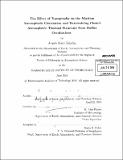The effect of topography on the Martian atmospheric circulation and determining Pluto's atmospheric thermal structure from stellar occultations
Author(s)
Zalucha, Angela M. (Angela Marie)
DownloadFull printable version (17.90Mb)
Other Contributors
Massachusetts Institute of Technology. Dept. of Earth, Atmospheric, and Planetary Sciences.
Advisor
R. Alan Plumb.
Terms of use
Metadata
Show full item recordAbstract
Previous work with Mars General Circulation Models (MGCMs) has shown that the north-south slope in Martian topography causes asymmetries in the Hadley cells at equinox and in the annual average. To quantitatively solve for the latitude of the dividing streamline and poleward boundaries of the cells, the Hadley cell model of Lindzen and Hou [1988, J. Atmos Sci. 45, 216-2427] was modified to include topography. The model was thermally forced by Newtonian relaxation to an equilibrium temperature profile calculated with daily averaged solar forcing at constant season. Two sets of equilibrium temperatures were considered that either contained the effects of convection or did not. When convective effects were allowed, the presence of the slope component shifted the dividing streamline upslope, qualitatively similar to a change of season in the original Lindzen and Hou [1988 (flat) model. The modified model also confirmed that the geometrical effects of the slope are much smaller than the thermal effects of the slope on the radiative-convective equilibrium temperature aloft. The results are compared to a simple MGCM forced by Newtonian relaxation to the same equilibrium temperature profiles, and the two models agree except at the winter pole near solstice. The simple MGCM results for radiative-convective forcing also show an asymmetry between the strengths of the Hadley cells at northern summer and northern winter solstices. The Hadley cell weakens with increasing slope steepness at northern summer solstice, but has little effect on the strength at northern winter solstice. In the second part, a radiative-conductive model from Strobel et al. [1996, Icarus 120, 266-289] was used to least-squares fit Pluto stellar occultation light curve data. This model predicted atmospheric temperature based on surface temperature, surface pressure, surface radius, and methane and carbon monoxide mixing ratios, from which model light curves were able to be calculated. The model improves upon previous techniques for deriving Pluto's atmospheric thermal structure from stellar occultation light curves by calculating temperature (as a function of height) caused by heating and cooling by species in Pluto's atmosphere, instead of a general assumption that temperature follows a power law with height or some other idealized function. Fits were able to be performed for model surface radius, surface pressure, and methane mixing ratio with one of the 2006 datasets and for surface pressure and methane mixing ratio for other datasets from the years 1988, 2002, 2006, and 2008. It was not possible to fit for carbon monoxide mixing ratio and surface temperature because the light curves are not sensitive to these parameters. The model surface radius, under the assumption of a stratosphere only (i.e. no troposphere) model and radiative equilibrium, was determined to be 1180 +20/-10 kin, where the error bars are those from the formal least-squares fit and errors on the closest approach distance. The methane mixing ratio results are more scattered with time and are in the range of 0.18% to 1.78%. The surface pressure results show an increasing trend with time, although it is not as dramatic as the factor of 2 from previous studies. Finally, I demonstrate with a preliminary Pluto general circulation model the importance of the effect of atmospheric circulation on temperature and surface pressure.
Description
Thesis (Ph. D. in Atmospheric Science)--Massachusetts Institute of Technology, Dept. of Earth, Atmospheric, and Planetary Sciences, 2010. Cataloged from PDF version of thesis. Includes bibliographical references (p. 143-152).
Date issued
2010Department
Massachusetts Institute of Technology. Department of Earth, Atmospheric, and Planetary SciencesPublisher
Massachusetts Institute of Technology
Keywords
Earth, Atmospheric, and Planetary Sciences.